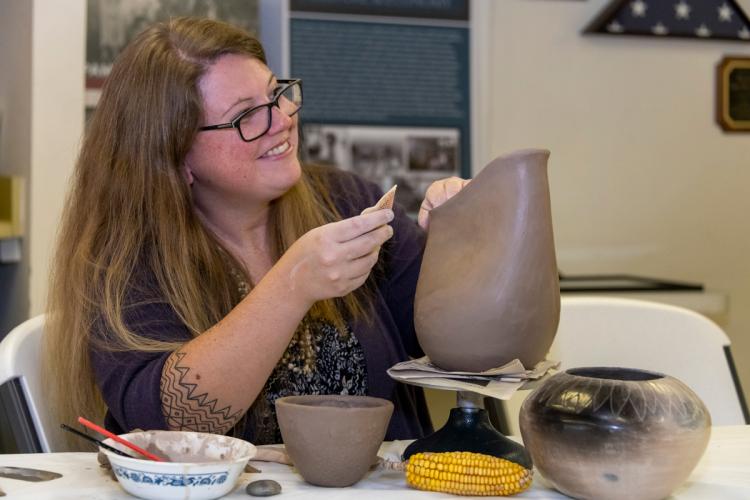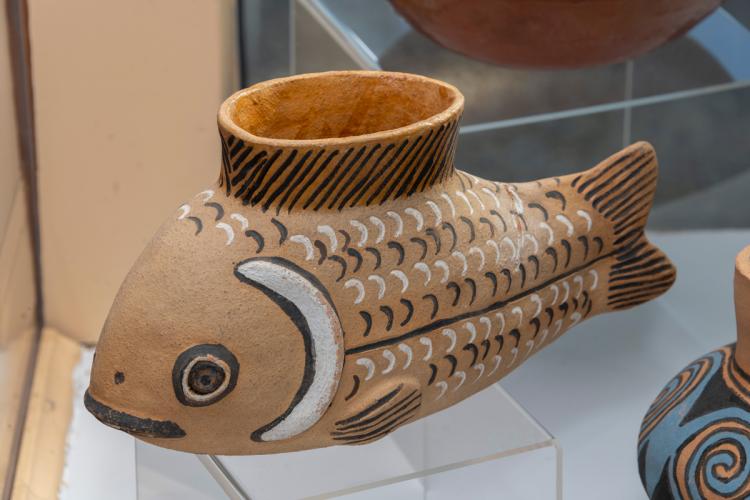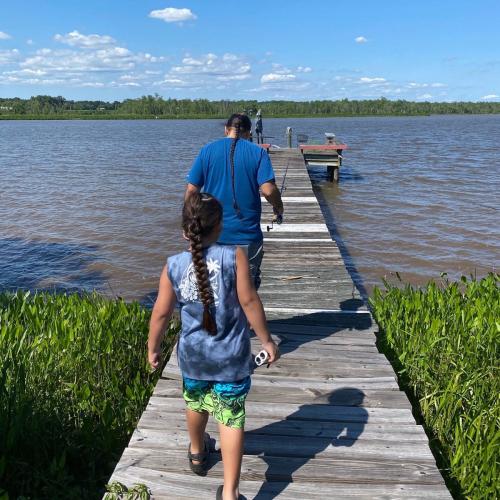About an hour east of Richmond, Virginia, lie the lands of the Pamunkey Indian Tribe, cradled in an arm of a river that bears their name. This river has sustained Indigenous people in this region for millennia. They journeyed on this waterway to the Chesapeake Bay only a few miles away and then to other American Indian communities along the East Coast. For many Pamunkey people, this river is their foundation and what enables them to perpetuate their culture.
“It is the draw of this land and of the river that brings us here and keeps us here,” said Debra Martin, a Pamunkey pottery maker. “We get our clay from this river. It is our lifeblood.”
Established in 1646, the Pamunkey Indian Reservation is potentially the oldest in the United States. Today it sits on only about 1,200 acres. The Pamunkey were one of 33 Algonquian-speaking tribes in the region known as the Powhatan Chiefdom. When European colonists arrived in 1607, they took lands from these tribes. Disease and conflict broke out, and after three wars and the deaths of many Native peoples, a number of the Powhatan tribes signed a treaty with the British Crown in 1677. The Pamunkey leader at the time, a woman the English called Queen Cockacoeske, was among those who agreed to the pact. Every year, the Pamunkey people continue to honor this treaty by bringing Virginia’s governor gifts, including a deer. Yet not until 2016 did the U.S. government recognize the Pamunkey Indian Tribe as a sovereign Native nation.
Since the colonists arrived, much of the Chesapeake Bay watershed has changed. For generations, Pamunkey families passed down locations of choice river banks from which men and children could dig the clay women used to make pottery. During the Great Depression of the 1930s, about a dozen Pamunkey women formed a guild to teach pottery making as well as create and sell their works in a one-room school on their reservation. The great-grandmother of Allyson Gray, a Pamunkey council member and pottery maker, was among them. Gray said pottery making was a time when “the whole community came together.”
But storms and rising water levels have eroded the river’s banks, and finding prime clay locations is ever more difficult. “Now you can only get to it when there is a very low tide,” explained Martin.
While a few women in the community continue to make pottery, the school that once buzzed with voices is silent. Tools lie on the tables and shelves as if they had been dropped there yesterday. Only the fire pit outside is occasionally still in use.
Other local resources that are in jeopardy are Atlantic sturgeon and shad. Both fish were essential sources of food and income for the Pamunkey people. But capturing and riding the mammoth sturgeon—which could be up to 16 feet long and 800 pounds—was also a rite of passage for young men.
Commercial fishing during the late 19th and early 20th centuries nearly wiped out the Atlantic sturgeon and shad populations. Dams have also blocked their journeys from rivers to the ocean and back again to spawn. Soil and fertilizers from development and farms have run off into the rivers, making them murky. This sediment smothers not only water-filtering marine life such as clams and mussels but the eggs that sturgeon lay on bedrocks. “The river has filled up. It is not as deep. Fish nets now drag the bottom,” said 94-year-old Pamunkey fisherman John Henry Langston.
Despite these challenges, the Pamunkey culture still thrives. For the past five years, staff from the National Museum of the American Indian’s education program, Native Knowledge 360° (American Indian.si.edu/nk360), have been working with members of the tribe on a teacher resource to convey just that. “Life Along the River” is a digital storybook for elementary school students about the Pamunkey people’s history and living culture. NMAI Teacher Services Coordinator Renée Gokey (Eastern Shawnee Tribe of Oklahoma) said the resource fills a gap in school curricula. “There just wasn’t a lot of accurate information about local tribes, and we were getting a lot of requests for this from teachers.”
This past October, NMAI and the tribe co-hosted a workshop for 20 teachers from Virginia and Maryland that began at its Pamunkey Indian Museum and Cultural Center on its reservation. The museum covers 12,000 years of Pamunkey history and features a range of traditional items, from pottery and clothing to fishing boats.
During the workshop, Gray and Martin demonstrated some pottery making techniques while fielding questions from the teachers. They also led the attendees on a short walk to the river, where the tribe’s hatchery stands across a pier from a handful of fishing cabins. The hatchery was established in 1918 to help replenish the local shad population. During a few weeks every spring, shad eggs would be hatched in tanks and the young fish, or fry, raised for a few days before being released into the river. But making sure the holding tanks were properly aerated was an around-the-clock job, and finding enough shad to provide and fertilize eggs is difficult, so it is currently closed. Langston, who managed the hatchery for a decade, commented that “I would like to see it operate again.”
Pamunkey citizen Kirk Moore initiated a project to research the local sturgeon population. With a grant from the National Oceanic and Atmospheric Administration (NOAA), Christian Hager of Chesapeake Scientific and Jason Kahn of NOAA employed tribal citizens April Deacy and Desiree Nuckols from 2018 to 2020 to count the adult sturgeon population in the Pamunkey River. While they counted less than 500 adult spawning fish annually, they did begin to see more new, younger fish.
Deacy said she has participated in the sturgeon project because she wants to help restore her river. “Water is life,” she said. “You take care of it, and it will take care of you.” To do so, the tribe has also planted a “living shoreline” along part of the river that will help slow soil erosion.
The in-person workshop was a memorable experience for the attendees. “To hear from people from the community who are preserving the culture and the knowledge was transformative,” said fourth-grade teacher Katie Blomquist.
Gray said she welcomed the opportunity to work with the teachers. “Learning in a respectful way is also how you are going to teach in a respectful way,” she said.
During two online workshops prior to their visit, the teachers previewed the digital storybook to be released this year. Second-grade teacher Jennifer Hoffmann said she is looking forward to using it in her classroom as Indigenous cultures are “so infrequently mentioned in curricula, and always in the past. I shift that balance to include more present-day voices.”
For Martin, the most important concept students could learn is that the Pamunkey people are “still here,” she said. “We still carry on. Generations before us have, and we will also.”



